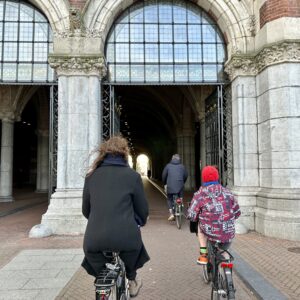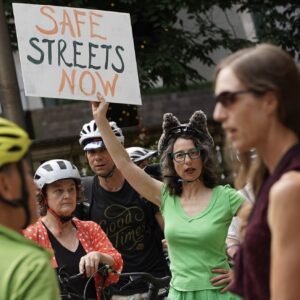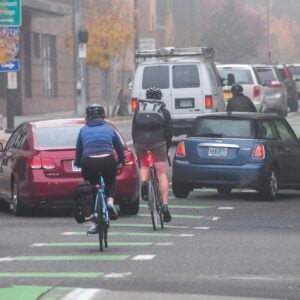Don’t miss this article by Jeff Mapes in today’s “inPortland” section of the Oregonian. Jeff (who is working on a book about how bikes are transforming cities around the world) accompanied the delegation of local bike advocates that went to Netherlands last month.
This discussion comparing Portland and Amsterdam is very intriguing to me. The article also gives insight into the thinking of the people that shape policies that affect our experience as cyclists in this city. Here are some of the quotes that stood out for me:
This one reminds us that our representatives were hard at work, not hardly working:
“Unlike many Amsterdam tourists, they (the Portland delegation) gawked at actual red lights, not the red-light district.”
This quote came from Sam Adams. It’s great to see he understands that we should go beyond anti-car rhetoric in our effort to get people out of cars:
“It’s not a question of browbeating single-occupancy drivers into submission. It’s developing options that are better.”
And here’s the word from a traffic safety expert in Amsterdam. And I’ll add that it is precisely the same point I make when people start complaining that bikes break traffic laws:
“When the speeds are low, the consequences are not severe,”
And this quote speaks to a fundamental difference in our laws and cultures:
“Dutch drivers can’t get a license until they are 18, and they have to spend thousands of dollars for instruction. They’re also assumed to be at fault if they collide with a pedestrian or bicyclist.”
And here’s my favorite quote. It comes from an Amsterdam traffic safety officer and echoes my argument about equal enforcement of bike and motor vehicle traffic laws:
“You can’t change that biker behavior,” he says, adding that the Dutch focus their resources on motorists because they do the most damage.
One final note. We’re lucky to have a guy like Jeff Mapes in a senior writing position at the Oregonian. This guy is the real deal and he completely understands the importance and potential of bikes to a healthy and sustainable future for our city. We’ll definitely be hearing more from him in the future.






Thanks for reading.
BikePortland has served this community with independent community journalism since 2005. We rely on subscriptions from readers like you to survive. Your financial support is vital in keeping this valuable resource alive and well.
Please subscribe today to strengthen and expand our work.
What a great article. Thanks for sharing it, Jonathan!
Some of the business community was over at Metro yesterday AM wringing their hands about congestion again. I rode over in the cool morning rain, arriving with a feeling like I had just made a great run down the Double Chair at Mt Hood. I’m looking forward to the day when these folks recognize that when we help two people convert auto trips into bike trips, we clear the way for a UPS truck!
Bikes are a key part of the solution.
You can say that again, Lenny! I always got questions from people when I rode my bike to work along the Boise River Greenbelt http://www.cityofboise.org/parks/Parks_facilities/parks/index.aspx?id=greenbelt in the middle of winter. They would ask, “Isn’t it cold riding your bike when its 25 degrees outside? Why don’t you get in a car like a ‘normal’ person?” …to which I would respond, have you ever been snow skiing? …well, just like when you go snow skiing, you wear clothing that is consistent with the weather!” It is a very simple concept. Granted, not everyone is physically able to ride their bike around Portland. However, there certainly are a lot more abled bodies than those we see now. I would love to see Portland streets look like those Amsterdam streets I saw earlier this year–teaming with bikes riden by children, adults, and Senior Citizens from all walks of life–not just spandex clad, helmet wearing, cyclists training for the next big race.
I thought it was a great article, but I was disappointed in a quote at the end – I think by Sam Adams, but I can’t confirm because the Oregonian’s !@@!#!@#$@$ web interface won’t let me – something to the effect that he’d love to be able to ride without a helmet, once the car:bike ratio in Portland was more like Amsterdam.
I wish cyclists (and politicians) would recognize that helmets are required to protect your head with or without car traffic!
my mistake – it was roger geller…
I think everyone recognizes the fact that helmets are there to protect you. But, those of us choose not to ride w/ them for various reasons. it’s a choice that effects only the rider.
There is also a good discussion of helmet use over at PortlandTransport.com.
Ah, damn my works internet blocks on random pages!
my point is that the lack of car traffic doesn’t decrease the need for a helmet.
at our bike commute challenge workshop, one of the BTA folks told a story about riding to work, no cars around, hearing a loud noise which scared a cat into her path, causing her to crash. the helmet saved her head.
when the bike coordinator implies you won’t need to protect your head when there are fewer cars, it’s disappointing.
Butting in as a helmet wearer since high school, I beg to differ about Roger’s point. He was not saying that ditching the helmet would be safer if there weren’t cars – he was saying one could go without a helmet if we rode as slowly as they do over there.
The redoubtable Todd Boulanger (shout out to the ‘Couve) had a hilarious piece in this year’s Filmed by Bike called “How to Ride Like a Dutchman.” The film contrasted the fully-suited up, bootied and helmet-covered fashion tragedy which is Portland riding in the rainy season, compareed to the elegance and sartorial elan of a typical Netherlandese, cruising languidly along in a suit, umbrella casually held aloft.
Todd’s point was that at normal Dutch speeds, you can ride holding an umbrella – very civilized.
Of course we live in the wild Western Hemisphere where speed is king.
not to mention the infeasibility of riding with umbrella in the East Wind… although I do like the image. (I still don’t think slower bike speeds obviate the need for helmets – you’re still 4-5 feet above pavement and pavement is still hard on skulls.) (I’ll stop now 🙂
There will always be instances where a helmet saves (or could have saved) somebody’s head. That is true whether you are riding a bicycle, walking along a street, or driving in a car (not to mention taking a shower in your home). I am not suggesting that people in Portland abandon their helmets (I wear mine). Rather, my goal is to create conditions on our streets, and see the skill level and “bicycle transportation intelligence” of individual cyclists increase to the point where people feel they no longer need helmets. I want to create conditions where the threat of head injury from riding a bicycle becomes comparable to or less than the threat of head injury from walking along a street, riding in an automobile (or taking a shower for that matter). [According to “The Perspectives Network,” whose primary focus is positive communication between persons with brain injury…” the two most common causes of head injury are vehicle accidents and accidents in the home]
In our recent trip to The Netherlands we saw many thousands of cyclists of all ages every day and saw no more than a handful of helmets, if that. Following is a brief essay I wrote in 1999 to a listserv for North American bicycle and pedestrian coordinators after returning to Portland from my first trip to The Netherlands.
July 6, 2000:
After returning to Portland from a family vacation in Amsterdam I’ve come to realize that I really dislike wearing a helmet. This dislike is focused on at least three different levels:
1. helmets advertise to motorists and other non-cyclists that bicycling is a dangerous activity.
2. helmets alter the manner in which I ride.
3. helmets are hot and mess up my hair.
Prior to this first visit to Amsterdam I had been a committed wearer of helmets since the age of 19 (I am now 40). In fact, I considered my use of a helmet to be a simple but powerful way to convey the message–as I carried it under my arm when entering a store, meeting, movie theater, etc.–that if I, a well-dressed, tie-wearing, innocuous-looking bureaucrat can ride a bicycle, then so can you! However, I have since been rethinking this and wondering if the helmet doesn’t also, and perhaps more forcefully, convey the message that bicycling is a hazardous activity (“Today, circumstances may prevail that cause me to fall on my head!”).
I ride primarily for transportation, and, upon our return to the states went helmetless for almost two months. I noticed that I rode slower without a helmet, taking extra precautions to not suffer from a single-vehicle crash. In the absence of bike lanes I rode in the middle of travel lanes. Not once did anybody honk at me, and in fact I got the sense that motorists were at some level more aware of my vulnerability and in response behaved themselves when near me. Of course I have no empirical evidence for this, however, on at leat one occasion a motorist next to whom I was stopped at a red light smilingly, timidly, (incredulously?) and questioningly gestured to me to ask where my helmet was and why was I not wearing it?
My helmet is back on my head, primarily due to peer and family pressure. Since I’ve recommenced wearing it I notice that I’ve resumed my fast-riding ways, gone back to weaving in and out of traffic, passing cars again on the right, and in general, taking more risks. This type of behavior is consistent with theories about risk-taking behavior that, generally stated, hypothesizes that as people (and systems) attain more protection, they also take more risks.
Of course, one of the reasons that 99.9% of the people I saw in Amsterdam (and throughout the cities we visited in The Netherlands and Belgium) did not wear helmets was becasue of favorable traffic conditions. Speed limits are lower (30 km/hr) and motorists are generally better behaved (reflected, perhaps, by the fact that stop signs are rarely used in Amsterdam–the overwhelming majority of non-signalized intersections are yield controlled).
So, what’s the point? The point is that despite all the facility improvements we put on the street, and despite signing the biekways to direct current and potential cyclists to them, unless we get a handle on slowing down automobiles and getting motorists to behave better, the streets will still seem scary to a lot of people who are “curious but yellow” about bicycling.
Contrast Amsterdam, where my wife and I both felt quite confident about riding throughout the city with our 8-year old son, with Portland, OR, where we have many miles of bike lanes and bike boulevards, but my wife and I still will not allow our son to ride the arterial near our home despite the presence of a bike lane. Facilities can only go so far in encouraging new cyclists. In Portland, with miles of facilities already in place, if I had a bunch of money I might invest it in efforts to slow down motorists and educate them about driving safely and considerately around cyclists, rather than build new facilities.
So, to make a long story short, I am suggesting that we expand the topic list to consider the question: “What can be done to create an automotive environment more conducive to bicycling?” If we can create on-street conditions such as are found in Amsterdam, then perhaps I can lose the helmet again.
Josh M. argues about helmet use that ” it’s a choice that [a]ffects only the rider. ”
This is untrue in several senses.
1) If you are insured, your head injury raises the premiums of every person in your insurance pool.
2) If you are uninsured your head injury is probably partially treated at taxpayer expense.
3) If you have any family or social responsibilities or loyalities your head injury deprives every one around you of the economic and human value of your life, to the extent that you are injured severely or killed.
You can’t sign a document that says “do not treat me at taxpayer expense if I’m injured and uninsured.” And good luck getting the people who love you to refuse to care for you when you are injured. They’re probably gonna do it, and it’s gonna cost them economicly and emotionally.
There really is no escape from the social bonds that come in to play when you injure yourself.
For that reason your decision to wear or nor wear a helmet should not be yours alone to make… it also belongs to those who feel an obligation to you and to those you have an obligation to.
To put it another way, your right to injure yourself stops where my obligation (and your friends’ and family’s?) obligation to care for you in a brain damaged state begins.
Being a member of society is hard but it is not an avoidable fate.
No person is an island. If it really was just about you then by all means take whatever chances you like. The problem is that in life it’s almost never ONLY about you.
(And no, I don’t particularly like helmets either but hey.)